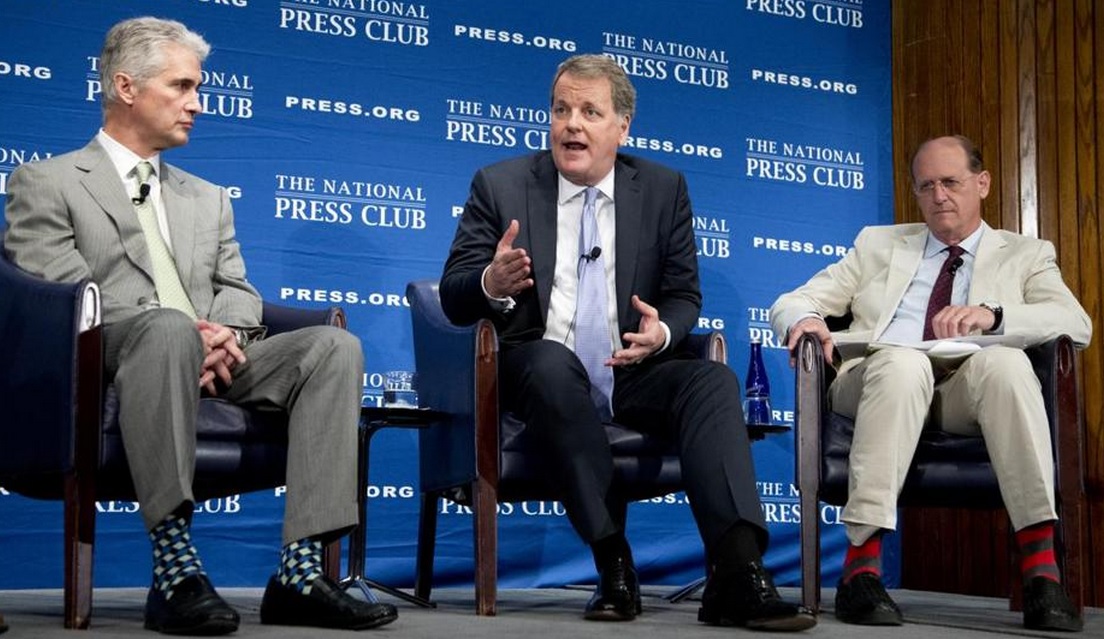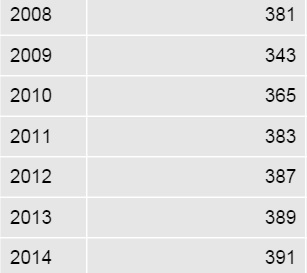Scott Mayerowitz and David Koenig broke the story that the Department of Justice is demanding copies of communications between major airlines as part of an investigation into unlawful collusion to limit capacity and increase airfares.
The civil antitrust investigation by the Justice Department appears to focus on whether airlines illegally signaled to each other how quickly they would add new flights, routes and extra seats.
A letter received Tuesday by major U.S. carriers demands copies of all communications the airlines had with each other, Wall Street analysts and major shareholders about their plans for passenger-carrying capacity.
As far as which airlines are targeted,
American Airlines, Delta Air Lines, Southwest Airlines and United Airlines all said they received a letter and are complying. Several smaller carriers, including JetBlue Airways and Frontier Airlines, said they had not been contacted by the government.
At this point we don’t know what evidence the Department of Justice has, or what basis there is to suspect an actual conspiracy amongst the major airlines to slow down airline growth.

The CEOs of United, American, and Delta All… Talking to Each Other
In the face of the double whammy of recession (which kept people out of the air) and high fuel prices, the airlines developed capacity discipline as a means of survival. It’s conceivable there were unlawful communications or signaling along the way and no doubt the Department of Justice will find that.
For pure schadenfreude one almost hopes to find a back and forth like when American’s Bob Crandall and Braniff’s Howard Putman spoke by phone about their competition over a variety of routes and then…
Mr. Crandall: I think it’s dumb as hell for Christ’s sake, all right, to sit here and pound the (expletive) out of each other and neither one of us making a (expletive) dime. I mean, you know, goddamn, what the (expletive) is the point of it?
Mr. Putnam: Nobody asked American to serve Harlingen, nobody asked American to serve Kansas City, and there were low fares in there, you know, before. So. …But if you’re going to overlay every route of American’s on top of, over, on top of every route that Braniff has – I can’t just sit here and allow you to bury us without giving our best effort.
Mr. Crandall: Oh sure, but Eastern and Delta do the same thing in Atlanta and have for years.
Mr. Putnam: Do you have a suggestion for me?
Mr. Crandall: Yes, I have a suggestion for you. Raise your goddamn fares 20 percent. I’ll raise mine the next morning. You’ll make more money and I will, too.
Mr. Putnam: We can’t talk about pricing.
Mr. Crandall: Oh [expletive], Howard. We can talk about any goddamn thing we want to talk about.
Putman was taping the call and turned it over to the DOJ…
To be clear nothing has been filed by the Justice Department, this appears to be the earliest stages of investigation.
I saw one report suggesting they were looking back at a time when airfares were dropping (2008-2009), but the AP reporters who broke the story pinpoint January 2010 as the date where DOJ wants details of each airline’s capacity.
Here are inflation-adjusted average airfares between 2008 and 2014 from the Department of Transportation’s Bureau of Transportation Statistics.
Indeed, it was 2011 before airfares recovered to the same level they were at in 2008. Average fares fell 10% between 2008 and 2009 and at most from January 2010 forward merely began returning to trend.

It’s clear that the capacity discipline that dominated the industry over the past 5 years has begun to dissipate, so the timing is ironic.
- With Southwest building up to 180 flights a day at Love Field, they’re killing American’s Dallas yields. (In addition, “Southwest said at an industry event that the carrier would increase passenger-carrying capacity by 7 to 8 percent, an increase over an earlier target.”)
- There’s also increased intensive competition on the only true premium domestic routes, New York – Los Angeles and San Francisco.
- United plans to increase capacity on several transatlantic routes removing 757s in favor of larger aircraft.
- American has been adding routes to Asia. And Delta and Alaska are duking it out in a fight to the death in Seattle.
I’m not saying there aren’t violations of law. That remains to be seen. Indeed, my starting point is an assumption that there are almost always anti-trust violations. Anti-trust is something you almost can’t not violate. If prices are too high, it’s indicative of market power. If prices stay the same it’s collusion. And if they’re too low it’s predatory pricing.
It would sure be rich, though, if the US government were to take action against Emirates, Etihad, and Qatar for putting too much capacity into US markets at the same time the government is investigating the major US airlines for withholding capacity.
But considering that the government signed off on the major US airline mergers, and granted anti-trust immunity to a variety of airline joint ventures, absent a smoking gun email any claim by the federal government that it’s “shocked, shocked to find” that there’s less competition in the airline industry is severely lacking in credibility.
Ultimately while airfares have been going up they’re still below where they were (in inflation adjusted terms) after 9/11. If we’re unhappy with that, it seems far more plausible to blame less competition (solution: eliminate foreign ownership restrictions on US airlines which keep out competitors) than it is to blame a conspiracy of airline heads who would have had every incentive to come to a deal and then cheat on that deal (cartels are notoriously hard to enforce).


I recall that some observers felt that the airline CEOs who attended the IATA AGM in Miami last month were telegraphing their strategies for capacity and pricing. That would seem to be enough to open a preliminary investigation. Because the airlines have shown group constraint it does beg the question as to whether or not there is an agreement of some sort, formal or not.
Maybe someone more informed than I can explain why each airline, DL UA AA and WN are all charging within two dollars of one another for their lowest fares from MCO to AUS on Day XX…I’m seeing UA at $145, AA at $146, WN at $147, DL at $148…try any hundreds of domestic combinations from point A to point B, same story. It is said that if something smells like fish it must be fishy…
@kimmie – you’re confusing collusion with signalling or mimicry. It’s basically the same reason why all the brands of gasoline, or salad dressing, or toilet paper all price themselves about the same too. When you’re a commodity and brand means very little, price is the only distinguishing factor and there’s nothing illegal about matching someone else’s price. What would be collusion is if all of the airlines decided what to set the price at, especially so if it could be demonstrated that the price was significantly above what competition would have settled it at.
I agree, that would be pureschadenfreude.
Oh, come the [expletive] on, Gary. The DOJ permits unprecedented airline consolidation, and we are all supposed to be surprised and dumbfounded by the idea carriers might be colluding? The level of deference you give the industry sometimes is frankly a disgrace. Commercial aviation is easily one of the most egregious examples of regulatory capture around (huge barriers to entry with strict controls of landing slots, international competition and the like, massive gov’t subsidization of the infrastructure carriers leverage, etc), and you want us to think this is friggin’ Silicon Valley? In an industry where there are only 3.5 relevant players selling a completely commoditized product, should our prior really be to believe that they are intensely competitive? You have the burden of proof totally misplaced.
Not to mention your shoddy “welp, fares only just recently got back to their 06-07 peak levels” economic analysis, which sounds like the kind BS lifted straight from the “trust us, we’ll behave” pre-merger industry propaganda. Did you ever consider that, perhaps, during the greatest credit-fueled economic bubble in history, average airfares may have found their way a touch above “normal” levels? Please, please stick to valuing miles and points, and steer clear of macroeconomic (or worse, legal) analysis.
Let them merge, let them consolidate, let them blow up when they are overexposed to fuel price swings, but above all, make them compete. And don’t apologize for them when they don’t.
-One of your loyal readers
@Chas I have written extensively on regulatory capture. But if you want to do something about it, this make believe political stunt ain’t it. Open competition by eliminating foreign ownership restrictions and you’ll get more airlines competing, more capacity, and lower prices.
That by the way is what the US airline industry fears most — why you can’t really call me an industry apologist, but also why the real solution ain’t gonna happen.
The problem with comparing airfare is that the numbers posted here do not include any ancillary revenue. No bag fees, food, e+, seating choice, etc included. That would add quite a bit to the fares shown for the most recent years. Real airfare is WAY up relative to 2007/2008 even adjusted for inflation.
Gary, I hope you get paid to write posts like this. If you don’t, you should. Your unblinking willingness to accept what free market participants tell you–to praise them for it, even–is remarkable. De-regulation isn’t always the solution, you know.
@Mike allowing more competition is the solution. There’s no universe in which a cabal between the airlines could be the cause of high prices, if you know anything at all about cartels. The airlines won’t like it. This is a very anti-US airline position. But we should allow foreign ownership of US carriers if we want competition.
@AAEXPlat inclusive of fees real airfare is still lower than in 2000.
http://airlines.org/data/annual-round-trip-fares-and-fees-domestic/
Gary, your penultimate paragraph says it all.
I love the picture of the three members of the “Whiners & Liars Club”. Take a look at the socks on two of them and we can speculate on their level of smarts.
@Gary
By no means do I think a couple DOJ lawsuits is the solution. What I have a problem with is your making subtle mockery of the idea that carriers are colluding or otherwise using uncouth practices (forget “legal” technical foot faults; I am talking about know-it-when-I-see-it type obviously unfair dealings). In an industry as consolidated as this one is we should be surprised to find honest competition- not the other way around.
@Chas – the industry certainly learned to be more careful, e.g. even the American-Braniff call referenced above Braniff walked away from. And when Doug Parker emailed Richard Anderson in 2010 inappropriately, Anderson forwarded the email to his general counsel and walked away. They’re not dumb.
If you think they’re colluding, why do 80% of attempted fare increases fail?
Four major domestic airlines and several more smaller players is hardly consolidated relative to any normal baseline even if it’s fewer airlines than before.